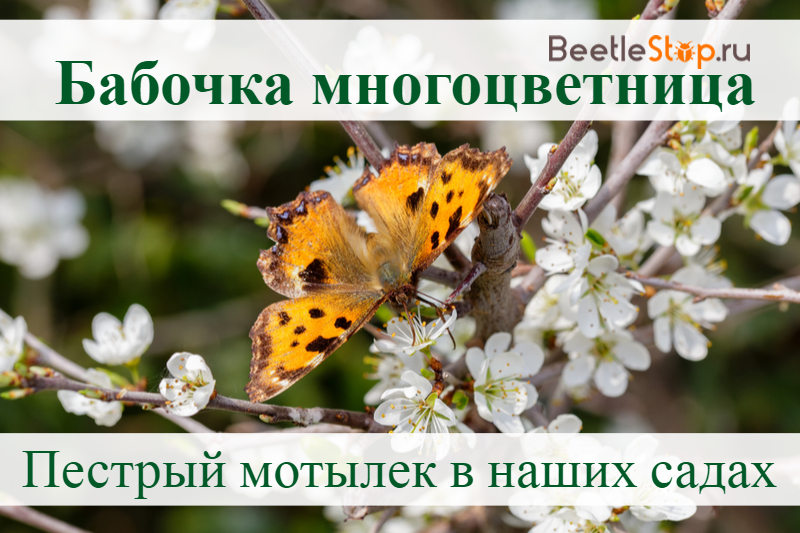Butterfly multicolor - sister twin hives
In early spring, on the trunks of trees you can see bright orange butterflies. At first glance, they look like hives - brick wings with black spots, a border with blue dots. But looking closer, differences become noticeable - fewer brown spots at the base of the wings, the blue color is not so saturated. This butterfly is a multiflorium; they with hives belong to the same family - nymphalids. A motley-colored moth is found in the temperate zone of Europe and Asia. A multi-flower garden is a frequent guest in gardens and parks.

View description
Multiflorum (Nymphalispolychloros) - a member of the nymphalide family. Its specific name "polychloros" in Greek means "multicolor". The butterfly is medium in size, the wingspan is 60 mm, the length of the front wing is 30 mm. The main color is orange, brownish at the base of the wings. The front and hind wings are covered with black and yellow spots of irregular shape.
A border of yellow and black stripes, as well as blue spots in the shape of a month, runs along the outer edge. The shape of the edges is wavy, there are protruding teeth. From underside, the wings are brownish-brown; the pattern imitates the bark of trees. The antennae are black club-shaped, the last segment of the club is light. The eyes are large, facet type, surrounded by scales. It has a mouth apparatus in the form of a proboscis for nectar and juice. The front legs are underdeveloped, move on four limbs.
Habitat
Butterflies Nymphalispolychloros are a common species of Eastern Europe; they are found up to 60 ° north latitude. They live in Sweden. Finland, in the south of England. Fly in Asia Minor, North Africa. In Russia, multi-flowering plants are common throughout Siberia. Butterflies belong to forest species, choose deciduous plantations, parks, gardens, shrubs. In the mountains they are found at an altitude of up to 1500 m.
Lifestyle
Imagoes of the multicolor appear from pupae in June. Young moths feed on secretions of trees, occasionally nectar of flowers. A multi-flower butterfly is perfectly masked on a tree trunk, where it spends most of its life. A few weeks later, the moths hide in a secluded place and fall asleep until the end of summer. In the fall they eat ripe fruit juice. Some individuals do not feed at all; after birth they become numb until the spring of next year.
Information. Moths ready for hibernation have a thick abdomen, but it is not filled with eggs, but with fat cells. This stock will help the butterfly survive the cold season without nutrition.
Wintering butterflies hide in the hollows of trees, in crevices, under the bark. If there are farm buildings nearby, then they fly into the attics, are placed in stacks of boards. Having woken up in early spring (in April), the multi-flowered trees drink juice flowing from the trees. Insects prefer oak, birch, fruit trees. Microelements are replenished on excrement and carcasses of animals. On sunny days, they fly actively, are prone to migration over significant distances.
Breeding
Spring years fall in April-May. Wintered butterflies replenish vital resources and prepare for reproduction. They give one generation a year. After mating, females lay 50-100 eggs, placing them in rings on young branches of fodder plants.They are oval in shape, red-brown, on the surface of 7-8 keels. Masonry begins in April, the embryonic stage takes 14-15 days.
Caterpillars of the first generation are brownish-gray with a large black head. Their length is 2 mm. The brood gathers together, is braided by a web and lives in a common colony. They eat leaves:
- hawthorn;
- poplar;
- elm;
- and you;
- birch and other deciduous trees.
Attention. Having settled in the garden, the larvae of the multicolor harm the apple trees, pears, cherries, plums. Growing offspring eats not only leaves, but also damages the fruits.
The development of the caterpillar takes 25-30 days, at the last (fifth) age they grow to 42-45 mm. The main body color is black and blue; longitudinal orange stripes are located on the back and sides. The body and head are covered with warts. A remarkable feature of the tracks is long, branched and sharp spikes. When destroying pests in the garden, it is better not to take them with your bare hands, the spike can pierce the skin and cause an allergic reaction.
Caterpillars hold together until pupation begins. When the time comes for a new stage of development, they slide off the tree. Pupae 24 mm long are hung upside down on stunted plants under the crown of a fodder tree. Pupa reddish-brown with silver and golden spots. This phase takes 1-2 weeks. In favorable conditions, young adults appear in May. For some time they fly along with last year's generation, which can be distinguished by frayed scales on the wings.

